Demolition Contractors Staples
Find top Demo Contractor in Staples
Get multiple Demolition Experts quotes for your project today! Compare profiles, reviews, accreditations, portfolio, etc... and choose the best deal.

High Idle Excavation
Farmingdale, USIntroducing High Idle Excavation Finding a reliable excavation contractor is crucial to the success of your project. Our experienced team at High Idle Excavation is here to make the process smooth and straightforward, turning your vision into reality with precision and efficiency. Based in Farmingdale, NY, we pride ourselves on being a locally owned and operated business, dedicated to delivering top-quality excavation services for residential and commercial clients. We offer an extensive range of services, which include expert land clearing, detailed site preparation, and precise grading and regrading. Whether you're looking to clear snow, or remove a parking lot or pool, we have the expertise and equipment to get the job done right. Our trenching and utility work ensure that your infrastructure projects are in capable hands, while our bobcat and demolition services provide the heavy-duty solutions needed for larger tasks. What sets us apart is having a comprehensive service portfolio and unwavering dedication to customer satisfaction. We offer free estimates and 24/7 emergency service calls, so no matter the time or the challenge, we're here for you. Our commitment to affordable, high-quality work means you get the best value without compromising on excellence. With a focus on friendly customer service and rapid project completion, we aim to make your excavation needs manageable and stress-free. Licensed and insured, High Idle Excavation stands ready to tackle all your excavation challenges with the professionalism and care you deserve. If you need top-notch excavation services in Farmingdale, NY, from site clearing to construction demolition, we invite you to reach out to us. Let us help turn your improvement plans into reality. Contact High Idle Excavation today to get started. Our Services Tackle your excavation project with confidence by calling High Idle Excavation at (516) 988-6600. Discover why we are the trusted excavator in Farmingdale, NY. Let's transform your property into a more usable space today! * Excavation Contractor * Excavating Services * Land Clearing * Snow Removal * Parking Lot Rip Outs * Pool Rip Outs * Trenching * Utility Work * Site Clearing * Demolition Services * Bobcat Services * Land Demolition * Grading Services * Regrading Services * Resloping Services * Site Preparation * Building Site Preparation * Construction Site Preparation * Construction Demolition * Equipment Rental * Equipment Transportation
- Services
- Why Us?
- Gallery
Get Quote
Excavation Contractors CT
3.73 reviews94 Sand Pit Rd, Danbury, 06810, USAbout Our Excavation Contractors in CT Excavation Contractors CT is the leading septic and excavation company servicing New Haven and Fairfield Counties. Our excavating contractors have been bringing expert excavation services to the Danbury and nearby areas for over 40 years, and understand what it takes to bring you the quality service you deserve. Whether for foundations, septic, swimming pools or otherwise, you can depend on our experienced team of excavation professionals to deliver results to exceed your expectations. Now you'll never have to ask the question, "Where's the best excavation companies near me?" again. The answer is Excavation Contractors CT. Why We're The #1 Team of Excavation Contractors in CT It may seem to some that excavating companies are all about moving dirt, and in some effects, it’s true. Yet, there is much more that goes into the services we bring to Danbury and the surrounding areas. From bringing professional septic excavation, to drainage trenches, site preparation and a whole list of other services, you can be sure that making the choice to bring in Excavation Contractors CT is making a step in the right direction. Professional and Affordable Excavation Services We are resident professionals when it comes to moving dirt, yet also provide you with the means to care for removed topsoil if required, and to bring a backfilling service you can count on throughout your project. Excavation Contractors CT brings the services needed to prepare homes for building, with the right foundation digging services and site preparation at hand, you have the capability to begin your work on a solidly laid foundation with our assistance. With the right digging and grading in place, your foundation experts can quickly make their way into position, bringing speed and efficiency to the overall build. This is where the talents and capabilities of our company truly shines, in bringing the essential services in order for follow up professionals to have a simple time with their work. It’s through these conjoined efforts that the task you have at hand is completed with speed, yet to high levels of accuracy. Expert Excavating Contractors in CT with Equipment to Match We provide Danbury and the surrounding area with a wide range of services in order to give you the means to work underground with ease. Our experts have been bringing their brand of specialized services to the area for over 40 years, and we are confident that we can provide you with the best possible service. We are committed to providing our clients with the highest quality excavation services at competitive prices. We are also committed to safety and environmental responsibility. We use the latest equipment and techniques to ensure that our work is done safely and efficiently. We are also committed to protecting the environment and minimizing our impact on the surrounding area.
- Services
- Why Us?
- Testimonials
- Gallery
Get Quote
AC Construction & Landscaping
41 reviewsDanbury, USAC Construction and Landscaping LLC We are more than committed to each of our clients to provide quality work that will help greatly enhance your property. Our greatest objective is to continue being the number one option for our clients. If you're planning your next residential or commercial makeover, We will handle all your construction needs. Contact the pros at AC construction and Landscaping LLC. We have a very experienced and reliable team of professionals. When it comes to landscaping services, we are the best option for you! We offer a full range of tree and landscaping services in CT and NY, we specialize in landscape design, installation, maintenance services, tree removal, landscape planting, transplanting, and a variety of construction services. We can turn your front and backyard into a beautiful haven that you can be proud of. Our qualified and experienced crews are friendly and informative, making it seamless to plan your project with our landscape contractors. Why Choose Us? Our company takes care of every single detail of the construction process. Planning, designing, constructing, and furnishing a new facility or renovation. We take pride in ourselves and this is shown through the way we treat our customers and by providing a quality service.
- Services
- Why Us?
- Gallery
Get Quote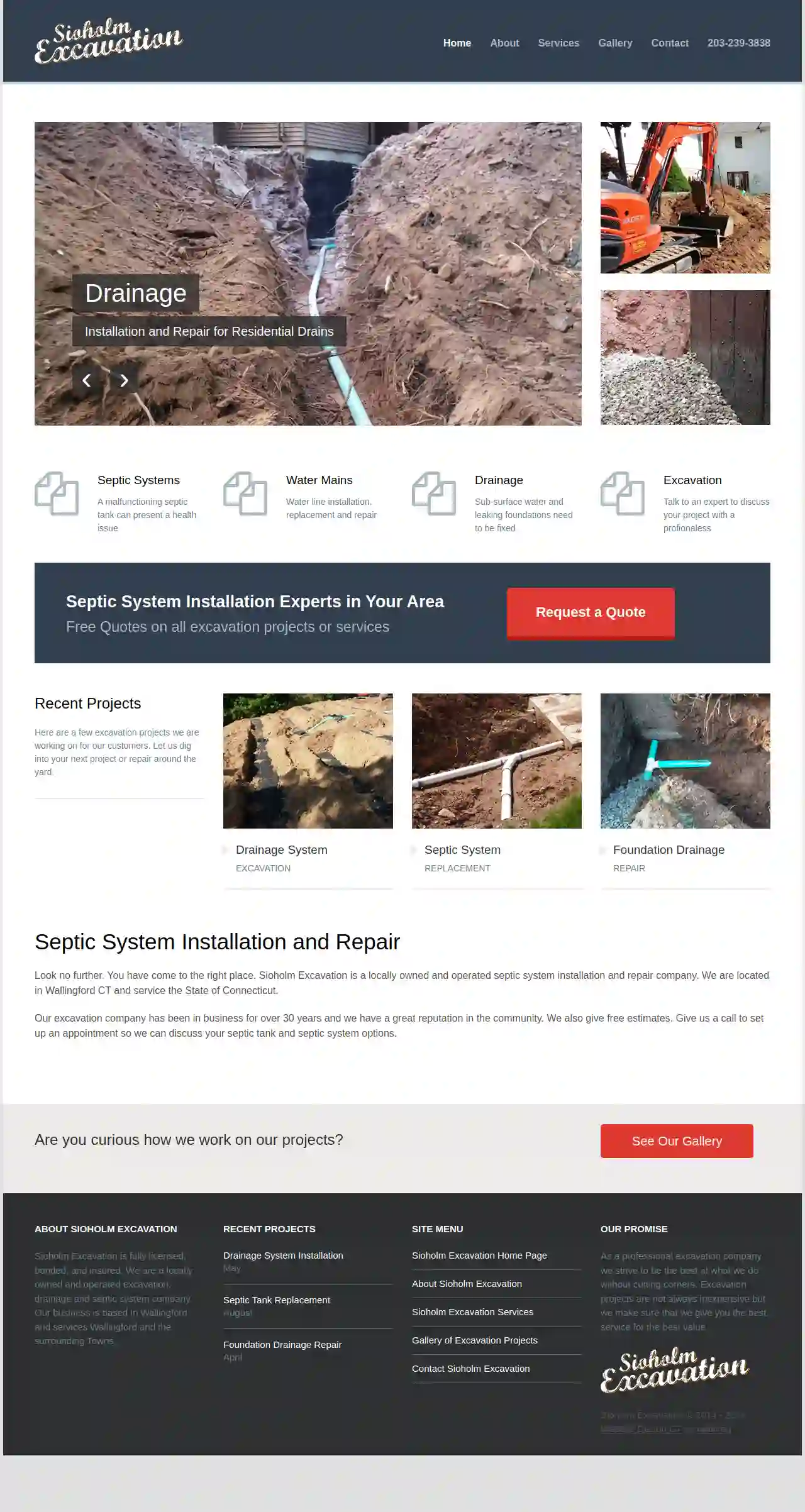
Sioholm Excavation
48 reviews42 New Place Street, Wallingford, 06492, USAbout Sioholm Excavation Sioholm Excavation is a locally owned and operated excavation, drainage and septic system company. We are fully licensed, bonded, and insured. Our business is based in Wallingford and services Wallingford and the surrounding Towns. Our Promise As a professional excavation company we strive to be the best at what we do without cutting corners. Excavation projects are not always inexpensive but we make sure that we give you the best service for the best value. Experience With over 3 Decades of Excavation Experience, let Sioholm Excavation help you with your installation or repairs for your home or business. Throughout the years, Sioholm Excavation has helped hundreds of customers fix their septic systems, sewer, water main, drainage and other issues as quickly as possible for a fair price. We take pride helping customers as quickly and efficiently as possible. Services Sioholm Excavation Services offers high quality installations and repairs on all types of excavation and site projects. With professional service, Sioholm Excavation is a company with years of experience who takes pride in each and every job while providing exceptional customer service. Being able to provide residential and commercial excavation services throughout Connecticut, Sioholm Excavation can work with your contractors for new construction or help you with your repairs. From septic systems to all types of property drainage, we are the number one choice for your excavation services and we will provide FREE estimates to help you figure out what your project will cost. We also can help recommend excavation solutions for certain types of problems so you can insure a complete job that works. Sioholm Excavation is committed to helping homeowners and businesses with all of their excavations needs. Professional service and quality workmanship, Sioholm Excavation is ready for your next project. Teamwork Our company is experienced in collaboratively working with all parties involved in a given project, including the homeowner, developer, general contractor, site and professional engineers, and other subcontractors. Testimonials SIoholm Excavation was there to help us get our septic system replaced right away. There is nothing worse than having no control over your water and septic system, and Bill Sioholm was there to help us get back on track. Wallingford Resident Values We pride ourselves on our honest and dependable services giving you trusted, high quality workmanship and the personal attention you deserve. Professional Dependable Courteous Experienced Knowledgeable
- Services
- Why Us?
- Testimonials
- Gallery
Get Quote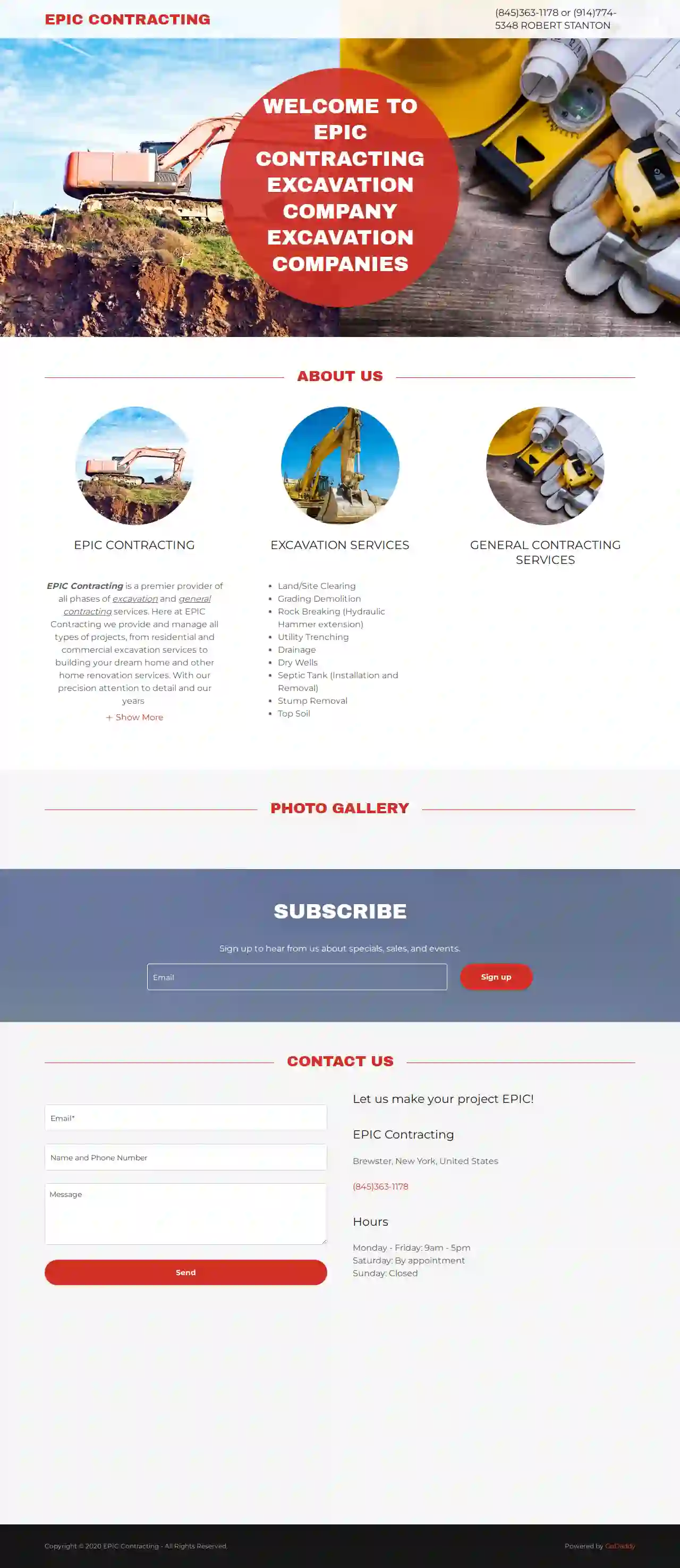
Epic Excavation & Contracting
Brewster, New York, United States, USAbout Us EPIC Contracting is a premier provider of all phases of excavation and general contracting services. Here at EPIC Contracting we provide and manage all types of projects, from residential and commercial excavation services to building your dream home and other home renovation services. With our precision attention to detail and our years of expertise, let EPIC Contracting handle the job and leave you with EPIC results. GENERAL CONTRACTING SERVICES EPIC Contracting is a premier provider of all phases of excavation and general contracting services. Here at EPIC Contracting we provide and manage all types of projects, from residential and commercial excavation services to building your dream home and other home renovation services. With our precision attention to detail and our years of expertise, let EPIC Contracting handle the job and leave you with EPIC results. EXCAVATION SERVICES EPIC Contracting is a premier provider of all phases of excavation and general contracting services. Here at EPIC Contracting we provide and manage all types of projects, from residential and commercial excavation services to building your dream home and other home renovation services. With our precision attention to detail and our years of expertise, let EPIC Contracting handle the job and leave you with EPIC results.
- Services
- Why Us?
- Gallery
Get Quote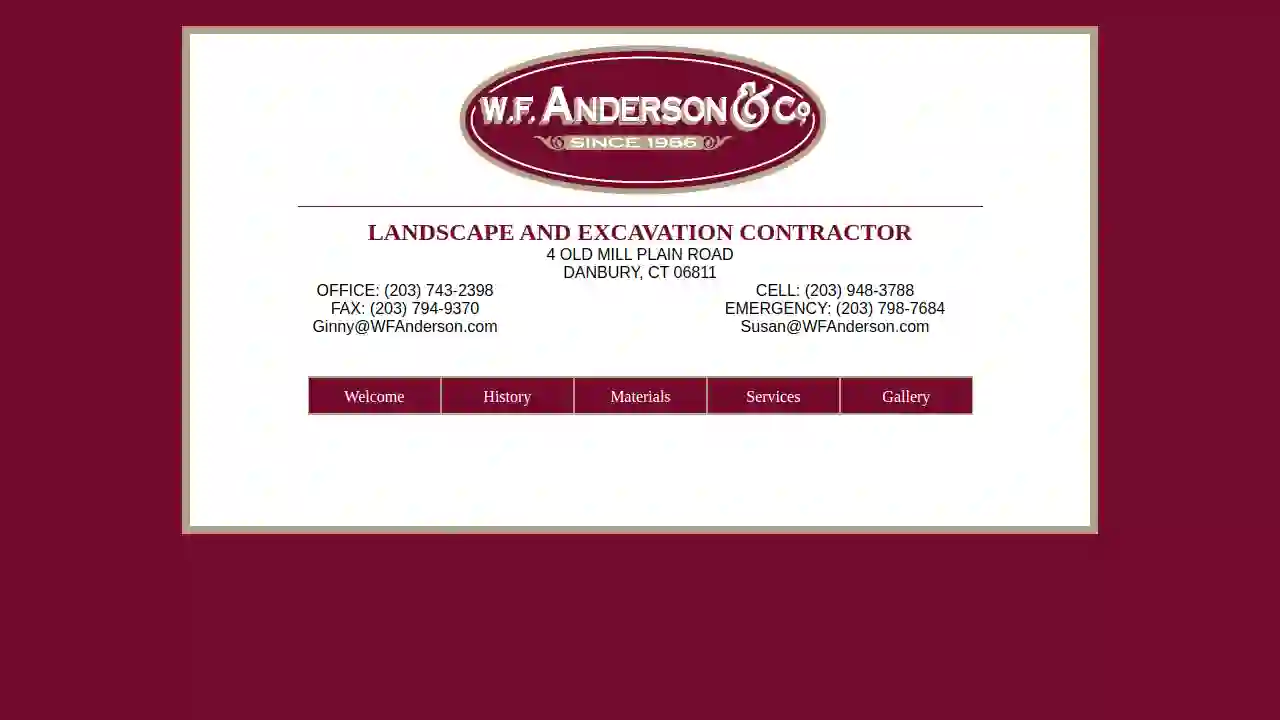
W F Anderson Construction LLC
4.84 reviews4 OLD MILL PLAIN ROAD, DANBURY, 06811, USWelcome WF Anderson is a family-owned and operated business with over 30 years of experience in the landscape and excavation industry. We are committed to providing our clients with the highest quality workmanship and customer service. We offer a wide range of services to meet your needs, from small residential projects to large commercial developments. We are fully licensed and insured, and we are proud to be a member of the Better Business Bureau. History WF Anderson was founded in 1990 by William F. Anderson. Bill has over 40 years of experience in the construction industry. He is a skilled and experienced contractor who is dedicated to providing his clients with the best possible service. Bill's son, William F. Anderson Jr., joined the business in 2000. Bill Jr. has over 20 years of experience in the landscape and excavation industry. He is a licensed and insured contractor who is committed to providing his clients with the highest quality workmanship and customer service. Materials We use only the highest quality materials for all of our projects. We are committed to using environmentally friendly products whenever possible. We offer a wide variety of materials to choose from, including: - Stone - Gravel - Sand - Topsoil - Mulch Services We offer a wide range of services to meet your needs, including: - Site preparation - Excavation - Grading - Landscaping - Drainage - Retaining walls - Patios - Walkways - Driveways - And more! Gallery We are proud of our work and we want to share it with you. Please take a look at our gallery to see some of our recent projects.
- Services
- Why Us?
- Gallery
Get Quote
L&C LANDCARE LLC
55 reviewsDanbury, USL&C LANDCARE LLC Your trusted lawn care and landscape maintenance experts in Fairfield County and surrounding areas. We offer a wide range of services to meet your needs, from lawn care and landscape maintenance to planting, removal, masonry, snow plowing, custom design ideas, and more. Our team of experienced professionals is dedicated to providing you with the highest quality service and results. We are committed to using environmentally friendly practices and products to protect your lawn and landscape. Contact us today for a free consultation and let us help you create the outdoor space of your dreams.
- Services
- Why Us?
- Gallery
Get Quote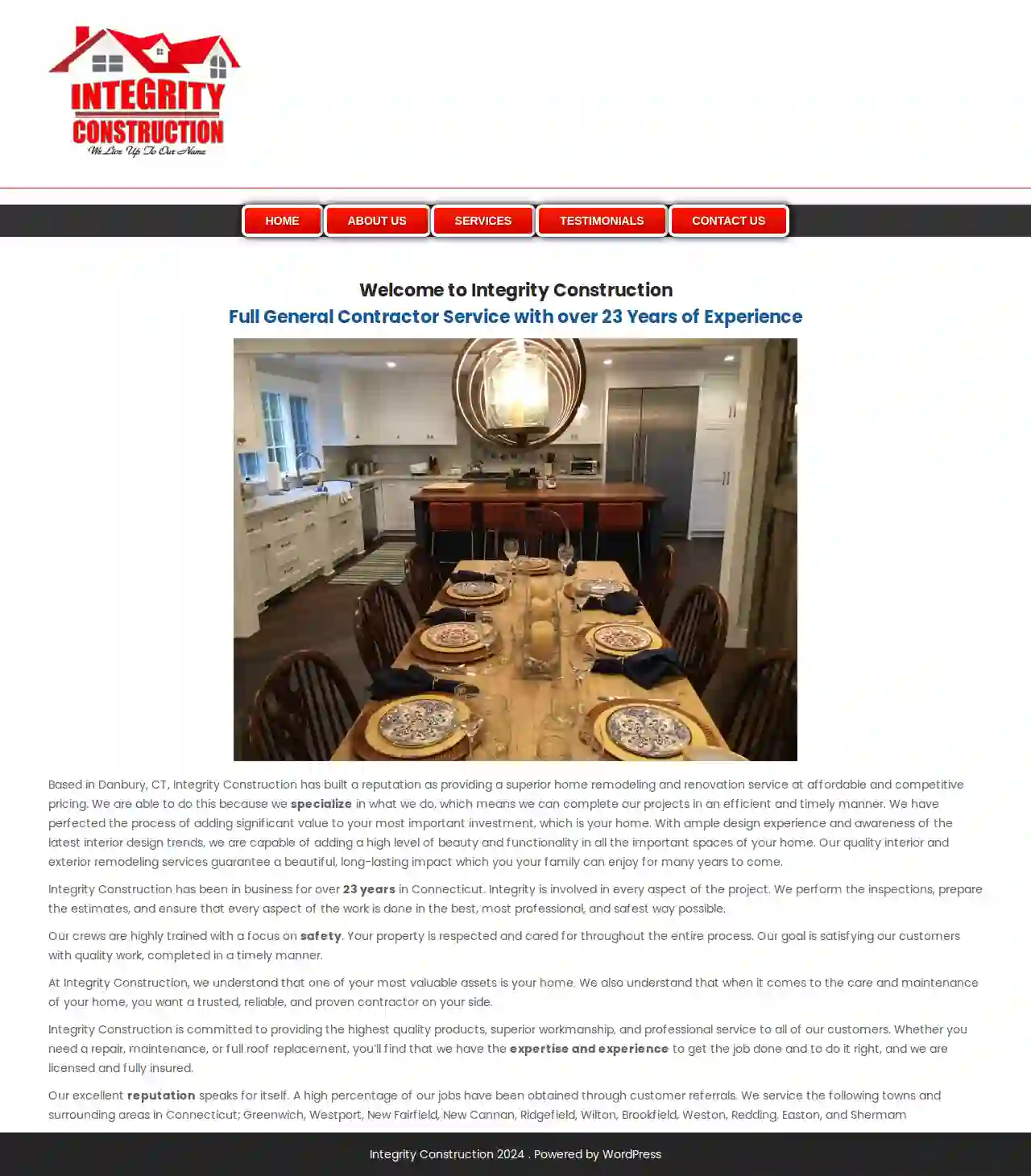
Integrity Construction
53 reviewsDanbury, USWelcome to Integrity Construction Full General Contractor Service with over 23 Years of Experience Based in Danbury, CT, Integrity Construction has built a reputation as providing a superior home remodeling and renovation service at affordable and competitive pricing. We are able to do this because we specialize in what we do, which means we can complete our projects in an efficient and timely manner. We have perfected the process of adding significant value to your most important investment, which is your home. With ample design experience and awareness of the latest interior design trends, we are capable of adding a high level of beauty and functionality in all the important spaces of your home. Our quality interior and exterior remodeling services guarantee a beautiful, long-lasting impact which you your family can enjoy for many years to come. Integrity Construction has been in business for over 23 years in Connecticut. Integrity is involved in every aspect of the project. We perform the inspections, prepare the estimates, and ensure that every aspect of the work is done in the best, most professional, and safest way possible. Our crews are highly trained with a focus on safety. Your property is respected and cared for throughout the entire process. Our goal is satisfying our customers with quality work, completed in a timely manner. At Integrity Construction, we understand that one of your most valuable assets is your home. We also understand that when it comes to the care and maintenance of your home, you want a trusted, reliable, and proven contractor on your side. Integrity Construction is committed to providing the highest quality products, superior workmanship, and professional service to all of our customers. Whether you need a repair, maintenance, or full roof replacement, you’ll find that we have the expertise and experience to get the job done and to do it right, and we are licensed and fully insured. Our excellent reputation speaks for itself. A high percentage of our jobs have been obtained through customer referrals. We service the following towns and surrounding areas in Connecticut; Greenwich, Westport, New Fairfield, New Cannan, Ridgefield, Wilton, Brookfield, Weston, Redding, Easton, and Shermam
- Services
- Why Us?
- Gallery
Get Quote
Fritcha's Construction
1662 Hartzell Road, New Haven, 46774, USFritcha's Construction: Your Trusted Excavating Partner in New Haven, IN Fritcha's Construction is a well-established excavating contractor based in New Haven, Indiana. We are dedicated to providing high-quality excavation services for a wide range of projects, from residential to commercial. Our team of experienced professionals is committed to delivering exceptional results while adhering to the highest safety standards. We understand the importance of precision and efficiency in every project. Our modern equipment and skilled operators ensure that your excavation needs are met with the utmost care and attention to detail. Whether you require site preparation, foundation excavation, utility installation, or any other excavating service, Fritcha's Construction is your reliable partner. We take pride in our commitment to customer satisfaction. We work closely with our clients to understand their specific requirements and provide personalized solutions that exceed their expectations. Our goal is to build lasting relationships with our clients based on trust, transparency, and exceptional service.
- Services
- Why Us?
Get Quote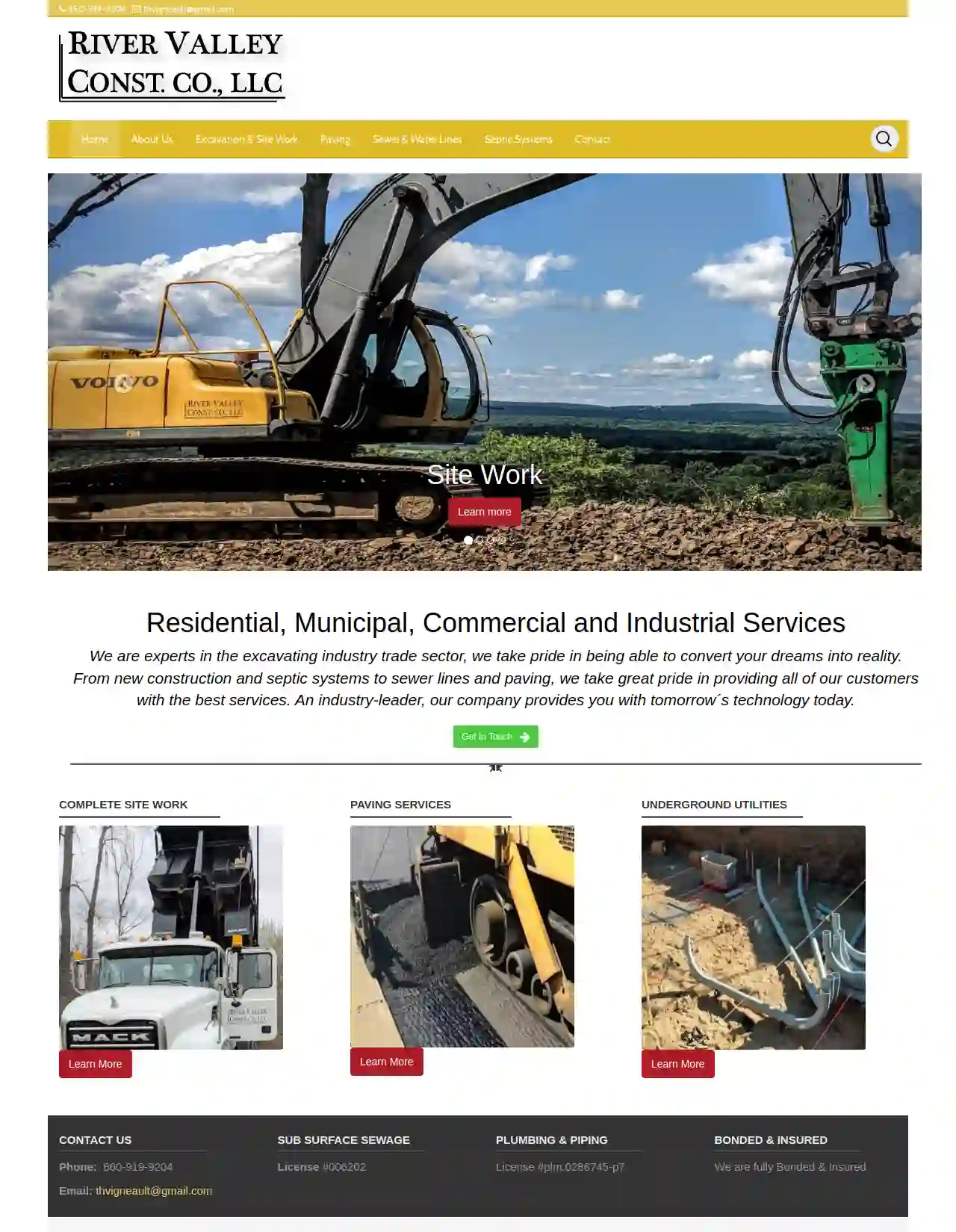
River Valley Construction Company, LLC
51 reviewsWaterbury, USResidential, Municipal, Commercial and Industrial Services We are experts in the excavating industry trade sector, we take pride in being able to convert your dreams into reality. From new construction and septic systems to sewer lines and paving, we take great pride in providing all of our customers with the best services. An industry-leader, our company provides you with tomorrow´s technology today.
- Services
- Why Us?
- Gallery
Get Quote
Over 22,076+ Excavation Contractors in our network
Our excavation providers operate in Staples & beyond!
ExcavationHQ has curated and vetted Top Excavation Companies in and around Staples. Find a reliable contractor today.
Frequently Asked Questions About Demolition Contractors
- Feasibility Studies: Assessing the viability and challenges of a demolition project.
- Demolition Planning: Developing demolition plans, including method selection, sequencing, and safety procedures.
- Permitting Assistance: Navigating the demolition permitting process and ensuring compliance with regulations.
- Hazardous Material Surveys: Identifying and managing hazardous materials, such as asbestos and lead paint.
- Cost Estimating: Providing accurate cost estimates for demolition services.
- Project Management: Overseeing the demolition process and ensuring it proceeds as planned.
- General Liability Insurance: Covers bodily injury or property damage to third parties caused by the contractor's negligence.
- Workers' Compensation Insurance: Provides benefits to workers injured on the job.
- Pollution Liability Insurance: Covers costs associated with environmental contamination caused by demolition activities.
- Professional Liability Insurance: Protects against claims of negligence or errors in professional services, such as demolition planning or consulting.
What is the role of a demolition consultant?
How do I find demolition contractors near me?
How long does a demolition project take?
What is the importance of insurance in demolition projects?
What is the role of a demolition consultant?
- Feasibility Studies: Assessing the viability and challenges of a demolition project.
- Demolition Planning: Developing demolition plans, including method selection, sequencing, and safety procedures.
- Permitting Assistance: Navigating the demolition permitting process and ensuring compliance with regulations.
- Hazardous Material Surveys: Identifying and managing hazardous materials, such as asbestos and lead paint.
- Cost Estimating: Providing accurate cost estimates for demolition services.
- Project Management: Overseeing the demolition process and ensuring it proceeds as planned.
How do I find demolition contractors near me?
How long does a demolition project take?
What is the importance of insurance in demolition projects?
- General Liability Insurance: Covers bodily injury or property damage to third parties caused by the contractor's negligence.
- Workers' Compensation Insurance: Provides benefits to workers injured on the job.
- Pollution Liability Insurance: Covers costs associated with environmental contamination caused by demolition activities.
- Professional Liability Insurance: Protects against claims of negligence or errors in professional services, such as demolition planning or consulting.